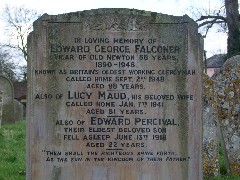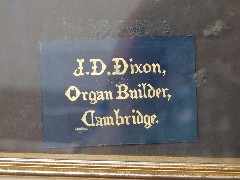| |
|
 |
|
Here we are where High
Suffolk comes down to meet the start of
the Gipping Valley, an area which has
been a meeting place for two thousand
years or more, an area of moots and
markets, of travellers and traders.
Around the town of Stowmarket, the
placenames reveal the pattern of the
past, and such a one is Old Newton. The
name is a pleasing contradiction, and the
parish is beautiful away from the busy
Stowmarket to Rickinghall Road. The best
view of the church is from the top the
hill on the back lane from Stowupland. I
came here in the early spring, when the
whole valley was still wearing its winter
clothes, but the sunshine promised much.
Closer to, the buds were on the trees,
and the green barley shoots spread across
the valley like a frost. I felt pleased
to have seen it before the trees were in
full leaf, and the church disappeared
back into its secretive copse. In the
graveyard you'll find Edward Falconer,
who died while Vicar of Old Newton in
1946, at the age of 98 years. He had been
Vicar here for more than half a century,
and his headstone tells you that he was known
as Britain's oldest working clergyman.
|
The
nave and chancel are mismatched in a pretty way,
the chancel high-ridged and red, the nave
flatter, simpler, without aisles or clerestories.
The chancel is pleasingly rough and ready, with
brickwork and wooden-traceried windows. The tower
is not big, but seems imposing against such a
simple building. You step through the rustic
south porch into a nave which seems wider than it
is, thanks to the low roof, with the beams proud
of the white ceiling. There's a nice west
gallery, screened off beneath, and the battered
15th Century font stands in front of it. In the gallery, the seating
is organised for children, boys on one side and
girls on the other. There are also places for
Master and Mistress.
Looking
east, everything is simple and seemly. There was
a staunchly Anglican restoration here in the 19th
Century, and this period created an impression of
substance and significance which chimes well with
the Decorated windows. Unusually, the location of a nave altar is revealed, not by a piscina, but by a surviving sedilia.
| Perhaps the most interesting
things here are idiosyncracies. The war
memorial is one of the strangest I've
ever seen, cut as fretwork in the style
of an indian temple, or perhaps the
Brighton Pavilion. The organ, up in the
chancel, is a fine modern one, but the
makers plate and memorial plaque from the
old one are displayed beside it, along
with the paperwork, a satisfying
historical detail. There is some 15th
Century canopywork up in the top of a
nave window, as well as some fragmentary
beasts, who provide, just for a moment, a
reminder of what was once here. Arthur Mee, an
enthusiast if ever there was one, rather
damns Old Newton with faint praise.
Forced into a perusal of the registers to
find something interesting to say, he
homes in on John Mole, the son of a farm
labourer, who was baptised here in 1743.
He astonished his friends with his
marvellous calculating powers, and
went on to write two books about algebra.
Mee also tracks down John Bridges, who
was a vicar's son in the 19th century,
and is best remembered as one of the
leaders of the modern system of
philosophy called Positivism. What
induced such a tiny, rural parish to give
birth to two great thinkers? Something in
the water? A curiosity to ponder, in such
an utterly rural churchyard.
|
|
 |
|
|
|

